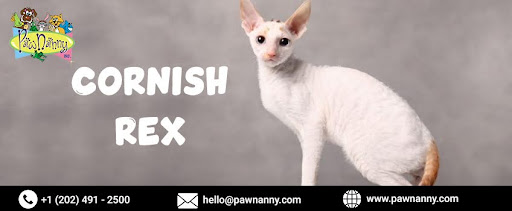
Cornish Rex
Size: 10-12 inches
Weight: 5-10 pounds
Hypoallergenic: Yes
Lifespan: 12-15 years
Behavior
The Cornish Rex is renowned for its distinctive behavior, marked by its playful and affectionate nature. Known as the "velcro cat," they form strong bonds with their human companions and crave constant attention. Unlike some breeds that prefer solitude, Cornish Rex cats thrive on interaction and often enjoy being the center of attention in the household even during overnight pet sitting.
Their high energy levels make them enthusiastic participants in interactive play, and they excel at learning tricks and playing games with their owners. This breed is notorious for its love of climbing and exploring, so providing ample opportunities for mental and physical stimulation is essential to keep them happy and healthy. Despite their playful demeanor, Cornish Rex cats are also deeply affectionate creatures. They enjoy snuggling up with their humans and have a knack for finding the coziest spots in the house. Many owners describe them as "lap cats" who relish any opportunity for cuddling and affectionate grooming sessions.
Additionally, Cornish Rex cats are known for their vocalizations, often engaging in chirping, trilling, and other unique sounds to communicate with their owners. This verbal communication adds to their endearing charm and strengthens the bond between cat and caregiver.
History
The history of the Cornish Rex breed is as unique as its appearance. Originating from Cornwall, England, in the early 1950s, the Cornish Rex is the result of a natural genetic mutation. The first Cornish Rex kitten, named Kallibunker, was born in a litter of barn cats on a farm in Bodmin Moor. Unlike his littermates, Kallibunker had a distinctive curly coat, which caught the attention of his owner, Nina Ennismore. Intrigued by this unusual trait, Ennismore began breeding Kallibunker in an effort to perpetuate his distinctive appearance.
The Cornish Rex breed's gene responsible for its unique coat is a recessive mutation, making it necessary to carefully select breeding pairs to maintain the breed's characteristics. Early breeders crossed Kallibunker with other cats, including Siamese and Burmese, to introduce genetic diversity and establish a breeding program. Through selective breeding, the Cornish Rex breed gradually gained popularity and recognition, attracting enthusiasts fascinated by its curly coat and playful personality.
In the 1960s, Cornish Rex cats were exported to the United States, where they quickly gained admirers. The breed's elegant appearance and affectionate nature endeared it to cat lovers around the world, leading to its widespread popularity as a companion animal. Despite its humble beginnings as a barn cat, the Cornish Rex became a cherished breed known for its intelligence, agility, and engaging personality.
Looks and Health
The Cornish Rex breed is instantly recognizable for its distinctive appearance and unique coat. Characterized by its slender, elegant body, large ears, and long, slender legs, the Cornish Rex stands out in the feline world. One of the most striking features of the breed is its soft, wavy coat, which lacks the typical guard hairs found in most cat breeds. Instead, the Cornish Rex's coat consists of a fine, downy undercoat, giving it a soft, velvety texture. This lack of guard hairs also means that the Cornish Rex sheds less than other breeds, making it a popular choice for those with allergies. In addition to its physical appearance, the Cornish Rex is known for its playful and affectionate nature. These cats are highly social and enjoy spending time with their human companions. They are often described as "dog-like" in their behavior, eagerly following their owners around the house and even learning to fetch toys. Despite their energetic nature, Cornish Rex cats are also known for their love of cuddling and are often found curled up in their owner's lap or nestled under the covers at bedtime.
While the Cornish Rex is generally a healthy breed, like all cats, they can be prone to certain health issues. One common concern is hypertrophic cardiomyopathy (HCM), a condition that affects the heart muscles and can lead to heart failure if left untreated. Regular veterinary check-ups and screenings can help to detect and manage this condition early on. Additionally, Cornish Rex cats may be more susceptible to respiratory infections due to their delicate respiratory systems. Providing a clean and stress-free environment can help to minimize the risk of respiratory issues and keep these energetic cats healthy and happy for years to come.
Food and Nutrition
Cornish Rex cats have unique nutritional needs that require special attention to maintain their health and vitality and every pet sitter during pets overnight stays must be well versed. Due to their high metabolism and active nature, providing a balanced diet is crucial for their overall well-being. Quality cat food formulated specifically for their age, size, and activity level is essential for meeting their dietary requirements. Protein is a key component of a Cornish Rex's diet, as it helps support their lean muscle mass and energy levels. Look for cat foods with high-quality protein sources such as chicken, turkey, or fish. Additionally, amino acids like taurine are vital for maintaining heart health and proper vision in these active felines. Fats are another important nutrient for Cornish Rex cats, providing them with essential fatty acids like omega-3 and omega-6, which contribute to healthy skin and a shiny coat. Opt for cat foods with moderate fat content to prevent obesity while still meeting their energy needs. Carbohydrates should be included in their diet in moderation, preferably in the form of digestible grains like rice or oats. Cornish Rex cats may benefit from diets with limited or no grains, especially if they have sensitivities or allergies to certain ingredients.
It's essential to provide fresh water at all times to keep Cornish Rex cats hydrated, especially since they tend to be more active than other breeds. Adequate hydration supports their kidney function and overall health.
Regular meals and portion control are crucial for preventing obesity in Cornish Rex cats, as they have a tendency to overeat if given the opportunity. Feeding them smaller, more frequent meals throughout the day can help regulate their metabolism and prevent excessive weight gain. Consulting with a veterinarian to establish a tailored nutrition plan based on your Cornish Rex's individual needs and health status is highly recommended. With proper feeding and nutrition, Cornish Rex cats can enjoy a long, healthy life full of energy and vitality.
Conclusion
The Cornish Rex is a distinctive breed known for its unique appearance and playful personality, making it a delightful pet for many cat lovers. As a pet, Cornish Rex cats are affectionate and highly social, often forming strong bonds with their human companions. They enjoy being in the center of attention and thrive on interaction even during pet house sitting services, making them great companions for families or individuals seeking an engaging feline friend. Their sleek, soft coat requires minimal grooming, contributing to their appeal as low-maintenance pets.
In the wild, the Cornish Rex's characteristics would likely afford it some advantages for survival. Their slender build and agility would aid in hunting small prey, while their friendly demeanor might help them form alliances within a feral cat community. However, their lack of a thick insulating coat might pose challenges in colder climates, requiring them to seek shelter or rely on alternative methods for staying warm. Despite these potential challenges, their intelligence and adaptability could serve them well in various environments.
Whether as a pet or in the wild, the Cornish Rex's distinctive traits contribute to its appeal and ability to thrive. With proper care and attention, these cats bring joy and companionship to their owners, while their unique characteristics offer insights into their potential roles and behaviors in natural settings. For more information, visit PawNanny.com .










